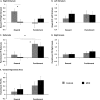Impaired reward prediction error encoding and striatal-midbrain connectivity in depression
- PMID: 29540863
- PMCID: PMC5983542
- DOI: 10.1038/s41386-018-0032-x
Impaired reward prediction error encoding and striatal-midbrain connectivity in depression
Abstract
Anhedonia (hyposensitivity to rewards) and negative bias (hypersensitivity to punishments) are core features of major depressive disorder (MDD), which could stem from abnormal reinforcement learning. Emerging evidence highlights blunted reward learning and reward prediction error (RPE) signaling in the striatum in MDD, although inconsistencies exist. Preclinical studies have clarified that ventral tegmental area (VTA) neurons encode RPE and habenular neurons encode punishment prediction error (PPE), which are then transmitted to the striatum and cortex to guide goal-directed behavior. However, few studies have probed striatal activation, and functional connectivity between VTA-striatum and VTA-habenula during reward and punishment learning respectively, in unmedicated MDD. To fill this gap, we acquired fMRI data from 25 unmedicated MDD and 26 healthy individuals during a monetary instrumental learning task and utilized a computational modeling approach to characterize underlying neural correlates of RPE and PPE. Relative to controls, MDD individuals showed impaired reward learning, blunted RPE signal in the striatum and overall reduced VTA-striatal connectivity to feedback. Critically, striatal RPE signal was increasingly blunted with more major depressive episodes (MDEs). No group differences emerged in PPE signals in the habenula and VTA or in connectivity between these regions. However, PPE signals in the habenula correlated positively with number of MDEs. These results highlight impaired reward learning, disrupted RPE signaling in the striatum (particularly among individuals with more lifetime MDEs) as well as reduced VTA-striatal connectivity in MDD. Collectively, these findings highlight reward-related learning deficits in MDD and their underlying pathophysiology.
Conflict of interest statement
The authors declare no competing interests.
Figures




Similar articles
-
Neural mechanisms of reinforcement learning in unmedicated patients with major depressive disorder.Brain. 2017 Apr 1;140(4):1147-1157. doi: 10.1093/brain/awx025. Brain. 2017. PMID: 28334960
-
Impaired reward-related learning signals in remitted unmedicated patients with recurrent depression.Brain. 2019 Aug 1;142(8):2510-2522. doi: 10.1093/brain/awz167. Brain. 2019. PMID: 31280309 Free PMC article.
-
Association between habenula dysfunction and motivational symptoms in unmedicated major depressive disorder.Soc Cogn Affect Neurosci. 2017 Sep 1;12(9):1520-1533. doi: 10.1093/scan/nsx074. Soc Cogn Affect Neurosci. 2017. PMID: 28575424 Free PMC article.
-
Involvement of basal ganglia and orbitofrontal cortex in goal-directed behavior.Prog Brain Res. 2000;126:193-215. doi: 10.1016/S0079-6123(00)26015-9. Prog Brain Res. 2000. PMID: 11105648 Review.
-
Prediction error in reinforcement learning: a meta-analysis of neuroimaging studies.Neurosci Biobehav Rev. 2013 Aug;37(7):1297-310. doi: 10.1016/j.neubiorev.2013.03.023. Epub 2013 Apr 6. Neurosci Biobehav Rev. 2013. PMID: 23567522 Review.
Cited by
-
Amphetamine disrupts haemodynamic correlates of prediction errors in nucleus accumbens and orbitofrontal cortex.Neuropsychopharmacology. 2020 Apr;45(5):793-803. doi: 10.1038/s41386-019-0564-8. Epub 2019 Nov 8. Neuropsychopharmacology. 2020. PMID: 31703234 Free PMC article.
-
A POMC-originated circuit regulates stress-induced hypophagia, depression, and anhedonia.Mol Psychiatry. 2020 May;25(5):1006-1021. doi: 10.1038/s41380-019-0506-1. Epub 2019 Sep 5. Mol Psychiatry. 2020. PMID: 31485012 Free PMC article.
-
Reward Network Modulation as a Mechanism of Change in Behavioral Activation.Behav Modif. 2020 Mar;44(2):186-213. doi: 10.1177/0145445518805682. Epub 2018 Oct 13. Behav Modif. 2020. PMID: 30317863 Free PMC article. Review.
-
Acute stress blunts prediction error signals in the dorsal striatum during reinforcement learning.Neurobiol Stress. 2021 Oct 27;15:100412. doi: 10.1016/j.ynstr.2021.100412. eCollection 2021 Nov. Neurobiol Stress. 2021. PMID: 34761081 Free PMC article.
-
Toward a Better Understanding of the Mechanisms and Pathophysiology of Anhedonia: Are We Ready for Translation?Am J Psychiatry. 2022 Jul;179(7):458-469. doi: 10.1176/appi.ajp.20220423. Am J Psychiatry. 2022. PMID: 35775159 Free PMC article. Review.
References
Publication types
MeSH terms
Grants and funding
LinkOut - more resources
Full Text Sources
Other Literature Sources
Medical
Miscellaneous

